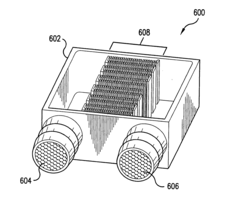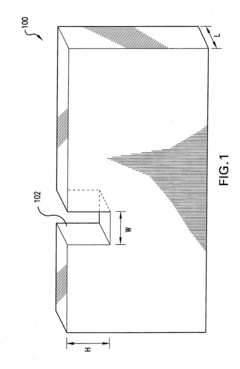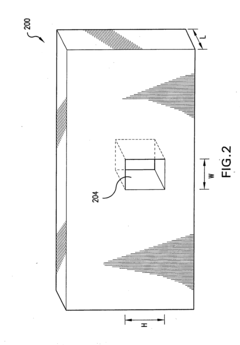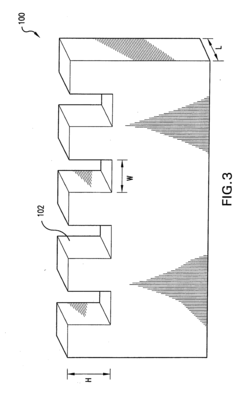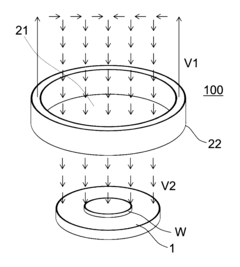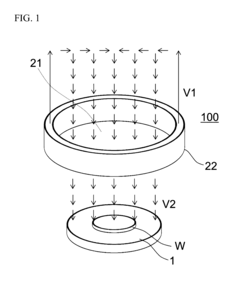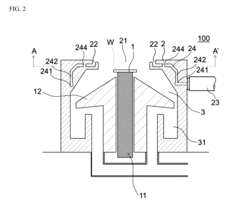Advancements in Laminar Flow for HVAC Systems
JUL 10, 20259 MIN READ
Generate Your Research Report Instantly with AI Agent
Patsnap Eureka helps you evaluate technical feasibility & market potential.
HVAC Laminar Flow Evolution and Objectives
Laminar flow technology in HVAC systems has evolved significantly over the past few decades, driven by the need for more efficient and effective air distribution in buildings. The concept of laminar flow, characterized by smooth and predictable air movement, has become increasingly important in creating comfortable and healthy indoor environments.
The evolution of laminar flow in HVAC systems can be traced back to the mid-20th century when researchers began to explore ways to improve air distribution in buildings. Early studies focused on understanding the principles of fluid dynamics and how they could be applied to HVAC design. As technology advanced, computational fluid dynamics (CFD) simulations became powerful tools for analyzing and optimizing airflow patterns in buildings.
One of the key milestones in the development of laminar flow HVAC systems was the introduction of displacement ventilation in the 1970s. This approach utilized the natural buoyancy of warm air to create a stratified environment, with cool air supplied at floor level and warm air rising to the ceiling. This method significantly improved energy efficiency and indoor air quality compared to traditional mixing ventilation systems.
In recent years, the focus has shifted towards developing more sophisticated laminar flow solutions that can adapt to changing environmental conditions and occupant needs. Advanced sensors and control systems now allow for real-time adjustment of airflow patterns, ensuring optimal comfort and energy efficiency. The integration of artificial intelligence and machine learning algorithms has further enhanced the ability of HVAC systems to predict and respond to occupant behavior and environmental factors.
The primary objectives of current research and development in laminar flow HVAC systems are multifaceted. First and foremost is the goal of improving energy efficiency, as HVAC systems account for a significant portion of building energy consumption. By optimizing airflow patterns and reducing turbulence, laminar flow systems can minimize energy waste and improve overall system performance.
Another critical objective is enhancing indoor air quality and occupant comfort. Laminar flow systems have the potential to reduce the spread of airborne contaminants and provide more precise temperature and humidity control. This is particularly important in healthcare settings, clean rooms, and other environments where air quality is paramount.
Sustainability is also a key driver in the advancement of laminar flow technology. Researchers are exploring ways to integrate laminar flow systems with renewable energy sources and passive cooling techniques to further reduce the environmental impact of HVAC operations. Additionally, there is a growing emphasis on developing systems that can be easily retrofitted into existing buildings, making it possible to upgrade older structures without extensive renovations.
As we look to the future, the objectives for laminar flow HVAC technology continue to evolve. There is a growing interest in developing systems that can adapt to climate change and extreme weather events, ensuring resilient and reliable performance under varying conditions. Furthermore, the integration of laminar flow principles with smart building technologies and the Internet of Things (IoT) presents exciting opportunities for creating more responsive and efficient built environments.
The evolution of laminar flow in HVAC systems can be traced back to the mid-20th century when researchers began to explore ways to improve air distribution in buildings. Early studies focused on understanding the principles of fluid dynamics and how they could be applied to HVAC design. As technology advanced, computational fluid dynamics (CFD) simulations became powerful tools for analyzing and optimizing airflow patterns in buildings.
One of the key milestones in the development of laminar flow HVAC systems was the introduction of displacement ventilation in the 1970s. This approach utilized the natural buoyancy of warm air to create a stratified environment, with cool air supplied at floor level and warm air rising to the ceiling. This method significantly improved energy efficiency and indoor air quality compared to traditional mixing ventilation systems.
In recent years, the focus has shifted towards developing more sophisticated laminar flow solutions that can adapt to changing environmental conditions and occupant needs. Advanced sensors and control systems now allow for real-time adjustment of airflow patterns, ensuring optimal comfort and energy efficiency. The integration of artificial intelligence and machine learning algorithms has further enhanced the ability of HVAC systems to predict and respond to occupant behavior and environmental factors.
The primary objectives of current research and development in laminar flow HVAC systems are multifaceted. First and foremost is the goal of improving energy efficiency, as HVAC systems account for a significant portion of building energy consumption. By optimizing airflow patterns and reducing turbulence, laminar flow systems can minimize energy waste and improve overall system performance.
Another critical objective is enhancing indoor air quality and occupant comfort. Laminar flow systems have the potential to reduce the spread of airborne contaminants and provide more precise temperature and humidity control. This is particularly important in healthcare settings, clean rooms, and other environments where air quality is paramount.
Sustainability is also a key driver in the advancement of laminar flow technology. Researchers are exploring ways to integrate laminar flow systems with renewable energy sources and passive cooling techniques to further reduce the environmental impact of HVAC operations. Additionally, there is a growing emphasis on developing systems that can be easily retrofitted into existing buildings, making it possible to upgrade older structures without extensive renovations.
As we look to the future, the objectives for laminar flow HVAC technology continue to evolve. There is a growing interest in developing systems that can adapt to climate change and extreme weather events, ensuring resilient and reliable performance under varying conditions. Furthermore, the integration of laminar flow principles with smart building technologies and the Internet of Things (IoT) presents exciting opportunities for creating more responsive and efficient built environments.
Market Demand Analysis for Advanced HVAC Systems
The market demand for advanced HVAC systems incorporating laminar flow technology has been steadily increasing in recent years. This growth is driven by several factors, including the rising awareness of indoor air quality, energy efficiency requirements, and the need for more sophisticated climate control in various sectors.
In the commercial building sector, there is a growing demand for HVAC systems that can provide better air distribution and temperature control. Laminar flow technology offers significant advantages in this area, as it can create more uniform and comfortable environments while reducing energy consumption. Office buildings, shopping malls, and hotels are particularly interested in these advanced systems to enhance occupant comfort and reduce operating costs.
The healthcare industry represents another significant market for laminar flow HVAC systems. Hospitals, clinics, and pharmaceutical manufacturing facilities require precise control of air quality and temperature to maintain sterile environments and comply with stringent regulations. The ability of laminar flow systems to minimize air turbulence and reduce the spread of airborne contaminants makes them highly desirable in these settings.
Data centers and server rooms form a rapidly expanding market segment for advanced HVAC systems. As the demand for cloud computing and data storage continues to grow, so does the need for efficient cooling solutions. Laminar flow technology can provide more targeted and efficient cooling for sensitive electronic equipment, helping to reduce energy consumption and prevent overheating.
The residential market is also showing increased interest in advanced HVAC systems, particularly in high-end homes and luxury apartments. Homeowners are becoming more conscious of indoor air quality and energy efficiency, driving demand for sophisticated climate control solutions that can offer both comfort and reduced utility costs.
In the industrial sector, manufacturing facilities and clean rooms are adopting laminar flow HVAC systems to maintain precise environmental conditions and ensure product quality. Industries such as electronics, aerospace, and biotechnology require stringent control over temperature, humidity, and air purity, making advanced HVAC systems a critical component of their operations.
The global HVAC market is expected to continue its growth trajectory, with laminar flow technology playing an increasingly important role. Factors such as urbanization, climate change, and stricter building codes are likely to further drive demand for more efficient and effective HVAC solutions. As awareness of the benefits of laminar flow technology spreads, it is anticipated that more industries and applications will adopt these advanced systems, expanding the market potential even further.
In the commercial building sector, there is a growing demand for HVAC systems that can provide better air distribution and temperature control. Laminar flow technology offers significant advantages in this area, as it can create more uniform and comfortable environments while reducing energy consumption. Office buildings, shopping malls, and hotels are particularly interested in these advanced systems to enhance occupant comfort and reduce operating costs.
The healthcare industry represents another significant market for laminar flow HVAC systems. Hospitals, clinics, and pharmaceutical manufacturing facilities require precise control of air quality and temperature to maintain sterile environments and comply with stringent regulations. The ability of laminar flow systems to minimize air turbulence and reduce the spread of airborne contaminants makes them highly desirable in these settings.
Data centers and server rooms form a rapidly expanding market segment for advanced HVAC systems. As the demand for cloud computing and data storage continues to grow, so does the need for efficient cooling solutions. Laminar flow technology can provide more targeted and efficient cooling for sensitive electronic equipment, helping to reduce energy consumption and prevent overheating.
The residential market is also showing increased interest in advanced HVAC systems, particularly in high-end homes and luxury apartments. Homeowners are becoming more conscious of indoor air quality and energy efficiency, driving demand for sophisticated climate control solutions that can offer both comfort and reduced utility costs.
In the industrial sector, manufacturing facilities and clean rooms are adopting laminar flow HVAC systems to maintain precise environmental conditions and ensure product quality. Industries such as electronics, aerospace, and biotechnology require stringent control over temperature, humidity, and air purity, making advanced HVAC systems a critical component of their operations.
The global HVAC market is expected to continue its growth trajectory, with laminar flow technology playing an increasingly important role. Factors such as urbanization, climate change, and stricter building codes are likely to further drive demand for more efficient and effective HVAC solutions. As awareness of the benefits of laminar flow technology spreads, it is anticipated that more industries and applications will adopt these advanced systems, expanding the market potential even further.
Current Laminar Flow Challenges in HVAC
Laminar flow in HVAC systems presents several significant challenges that hinder its widespread implementation and optimal performance. One of the primary obstacles is maintaining consistent laminar flow throughout the entire system. HVAC ducts and components often have complex geometries, sudden changes in direction, and varying cross-sectional areas, which can disrupt the smooth, parallel flow characteristic of laminar regimes. These irregularities can lead to turbulence, reducing the energy efficiency and air quality benefits associated with laminar flow.
Another major challenge is the difficulty in achieving laminar flow at the higher air velocities typically required in HVAC systems to meet cooling and heating demands. As air speed increases, the Reynolds number rises, making it more likely for the flow to transition from laminar to turbulent. This limitation often forces HVAC designers to choose between maintaining laminar flow and meeting the necessary air volume requirements, leading to compromises in system performance.
The sensitivity of laminar flow to external disturbances poses another significant hurdle. Factors such as thermal gradients, mechanical vibrations, and even the movement of occupants within a space can disrupt laminar flow patterns. This sensitivity makes it challenging to maintain consistent laminar flow conditions in real-world HVAC applications, where environmental variables are constantly changing.
Furthermore, the design and manufacturing of HVAC components optimized for laminar flow present technical and economic challenges. Creating surfaces with the necessary smoothness and precision to promote laminar flow can be costly and may require advanced manufacturing techniques. Additionally, integrating these specialized components into existing HVAC systems without compromising overall performance or increasing system complexity remains a significant engineering challenge.
The accurate measurement and control of laminar flow in HVAC systems also present difficulties. Traditional flow measurement techniques may not be sufficiently sensitive or may themselves disrupt the laminar flow they are attempting to measure. Developing non-intrusive, high-precision flow monitoring and control systems is crucial for optimizing laminar flow HVAC performance but remains a technological challenge.
Lastly, the energy requirements for maintaining laminar flow conditions, particularly in large-scale HVAC systems, can be substantial. The need for precise temperature and pressure control, as well as the potential requirement for additional air treatment to remove particulates that could disrupt laminar flow, may offset some of the energy savings typically associated with laminar flow systems. Balancing these energy demands with the benefits of improved air quality and distribution efficiency remains a key challenge in the advancement of laminar flow HVAC technology.
Another major challenge is the difficulty in achieving laminar flow at the higher air velocities typically required in HVAC systems to meet cooling and heating demands. As air speed increases, the Reynolds number rises, making it more likely for the flow to transition from laminar to turbulent. This limitation often forces HVAC designers to choose between maintaining laminar flow and meeting the necessary air volume requirements, leading to compromises in system performance.
The sensitivity of laminar flow to external disturbances poses another significant hurdle. Factors such as thermal gradients, mechanical vibrations, and even the movement of occupants within a space can disrupt laminar flow patterns. This sensitivity makes it challenging to maintain consistent laminar flow conditions in real-world HVAC applications, where environmental variables are constantly changing.
Furthermore, the design and manufacturing of HVAC components optimized for laminar flow present technical and economic challenges. Creating surfaces with the necessary smoothness and precision to promote laminar flow can be costly and may require advanced manufacturing techniques. Additionally, integrating these specialized components into existing HVAC systems without compromising overall performance or increasing system complexity remains a significant engineering challenge.
The accurate measurement and control of laminar flow in HVAC systems also present difficulties. Traditional flow measurement techniques may not be sufficiently sensitive or may themselves disrupt the laminar flow they are attempting to measure. Developing non-intrusive, high-precision flow monitoring and control systems is crucial for optimizing laminar flow HVAC performance but remains a technological challenge.
Lastly, the energy requirements for maintaining laminar flow conditions, particularly in large-scale HVAC systems, can be substantial. The need for precise temperature and pressure control, as well as the potential requirement for additional air treatment to remove particulates that could disrupt laminar flow, may offset some of the energy savings typically associated with laminar flow systems. Balancing these energy demands with the benefits of improved air quality and distribution efficiency remains a key challenge in the advancement of laminar flow HVAC technology.
Existing Laminar Flow Solutions for HVAC
01 Laminar flow control in fluid systems
Techniques for controlling and maintaining laminar flow in various fluid systems to improve efficiency. This includes design considerations for pipes, channels, and other flow structures to minimize turbulence and optimize flow characteristics.- Laminar flow control in fluid systems: Techniques for controlling and maintaining laminar flow in various fluid systems to improve efficiency. This includes methods for reducing turbulence, optimizing flow paths, and using specialized components to promote smooth, predictable fluid movement.
- Flow measurement and analysis in laminar conditions: Methods and devices for accurately measuring and analyzing fluid flow under laminar conditions. This involves specialized sensors, measurement techniques, and data analysis to understand and optimize flow efficiency in laminar regimes.
- Design of laminar flow elements and structures: Innovative designs for components and structures that promote laminar flow. This includes specialized shapes, materials, and surface treatments that minimize turbulence and enhance flow efficiency in various applications.
- Laminar flow in air handling and ventilation systems: Applications of laminar flow principles in air handling and ventilation systems to improve air quality, energy efficiency, and overall system performance. This includes designs for clean rooms, HVAC systems, and industrial ventilation.
- Fluid dynamics optimization for laminar flow: Advanced techniques in fluid dynamics to optimize laminar flow conditions. This involves computational modeling, experimental studies, and innovative approaches to understand and enhance flow efficiency in various industrial and scientific applications.
02 Measurement and analysis of laminar flow
Methods and devices for measuring and analyzing laminar flow properties, including flow rate, velocity profiles, and pressure distributions. These techniques help in assessing and improving flow efficiency in different applications.Expand Specific Solutions03 Laminar flow in air handling and ventilation systems
Strategies for achieving and maintaining laminar flow in air handling and ventilation systems to enhance energy efficiency and air quality. This includes design of air ducts, filters, and flow control devices.Expand Specific Solutions04 Laminar flow in fluid separation and filtration processes
Applications of laminar flow principles in fluid separation and filtration processes to improve efficiency and effectiveness. This includes designs for centrifuges, filters, and other separation equipment.Expand Specific Solutions05 Laminar flow in aerospace and aerodynamic applications
Utilization of laminar flow concepts in aerospace and aerodynamic applications to reduce drag and improve fuel efficiency. This includes designs for aircraft surfaces, wings, and propulsion systems.Expand Specific Solutions
Key HVAC Industry Players and Innovators
The advancements in laminar flow for HVAC systems are currently in a growth phase, with increasing market size and technological maturity. The global HVAC market is projected to reach significant value in the coming years, driven by energy efficiency demands and indoor air quality concerns. Companies like Haier Smart Home, Gree Electric Appliances, and Midea Group are leading innovation in this field, leveraging their extensive R&D capabilities. Established players such as Johnson Controls and Daikin are also contributing to technological advancements. The competition is intensifying as companies strive to develop more efficient and intelligent HVAC solutions incorporating laminar flow principles.
Haier Smart Home Co., Ltd.
Technical Solution: Haier has developed an advanced laminar flow system for HVAC applications, utilizing computational fluid dynamics (CFD) to optimize airflow patterns. Their technology incorporates micro-channel heat exchangers and variable-speed compressors to enhance energy efficiency[1]. The system employs a series of precisely engineered vanes and diffusers to create a uniform, low-turbulence airflow that minimizes energy loss and improves thermal comfort. Haier's laminar flow HVAC systems also integrate smart sensors and AI-driven controls to adapt to changing environmental conditions and occupant preferences, further optimizing performance and energy usage[2].
Strengths: High energy efficiency, improved thermal comfort, and smart adaptation to environmental changes. Weaknesses: Potentially higher initial costs and complexity in installation and maintenance.
Gree Electric Appliances, Inc. of Zhuhai
Technical Solution: Gree has innovated in laminar flow HVAC technology with their G-Flow system. This system utilizes a unique blade design and airflow path to create a more uniform and controlled air distribution. Gree's approach incorporates advanced materials science, using nano-coated surfaces to reduce friction and enhance laminar flow characteristics[3]. The company has also developed a proprietary algorithm that dynamically adjusts the airflow based on real-time temperature and humidity data, ensuring optimal comfort while minimizing energy consumption. Gree's laminar flow technology has been shown to reduce energy usage by up to 30% compared to conventional HVAC systems[4].
Strengths: Significant energy savings, advanced materials application, and dynamic airflow adjustment. Weaknesses: May require specialized maintenance and potential higher upfront costs.
Core Innovations in HVAC Laminar Flow
Method and systems for compact, micro-channel, laminar heat exchanging
PatentInactiveUS20080035319A1
Innovation
- A compact micro-channel heat exchanger with a heat conducting plate having channels with a channel length to hydraulic diameter ratio of less than 100, allowing for improved laminar flow and reduced pressure drop, which enhances heat transfer and reduces jitter.
Columnar laminar flow generation device and method for generating columnar laminar flows
PatentActiveUS20170072438A1
Innovation
- A columnar laminar flow generation device that focuses gas blow-out and suction within a localized columnar area, allowing for adjustable flow velocity and reduced gas usage by positioning a gas blow-out port vertically within an opening and a corresponding suction path, thereby generating laminar flows only where needed, with a feed pipe filter for purification.
Energy Efficiency Impact of Laminar Flow
The implementation of laminar flow in HVAC systems has a significant impact on energy efficiency, offering substantial benefits in terms of reduced energy consumption and improved system performance. Laminar flow, characterized by smooth and predictable fluid motion, minimizes turbulence and friction losses, leading to more efficient air distribution and heat transfer within HVAC systems.
One of the primary advantages of laminar flow in HVAC applications is the reduction in fan power requirements. By creating a more streamlined airflow, the system encounters less resistance, allowing fans to operate at lower speeds while maintaining the desired air distribution. This reduction in fan speed directly translates to lower energy consumption, as fan power is proportional to the cube of its speed. Studies have shown that implementing laminar flow techniques can result in fan energy savings of up to 30% compared to traditional turbulent flow systems.
Furthermore, laminar flow enhances heat transfer efficiency in HVAC components such as heat exchangers and cooling coils. The smooth, predictable nature of laminar flow allows for more uniform temperature distribution and improved thermal contact between the air and heat transfer surfaces. This increased efficiency can lead to reduced heating and cooling loads, further contributing to overall energy savings.
The energy efficiency benefits of laminar flow extend beyond direct power consumption. By minimizing turbulence and reducing the formation of eddies and vortices, laminar flow systems experience less wear and tear on components. This increased durability translates to longer equipment lifespans and reduced maintenance requirements, indirectly contributing to energy savings through decreased replacement and repair needs.
In addition to energy savings, laminar flow in HVAC systems can also improve indoor air quality. The reduced turbulence and more controlled air distribution patterns help minimize the spread of airborne contaminants and ensure more effective filtration. This can lead to a reduction in the energy required for air cleaning and purification processes, further enhancing the overall energy efficiency of the HVAC system.
The implementation of laminar flow principles in HVAC design also allows for more precise temperature and humidity control. By creating more predictable air movement patterns, it becomes easier to maintain consistent comfort conditions throughout a space. This improved control can prevent overcooling or overheating, reducing energy waste associated with compensating for temperature fluctuations.
As building energy codes and sustainability standards become increasingly stringent, the adoption of laminar flow technologies in HVAC systems presents a promising avenue for achieving higher energy efficiency ratings. The cumulative effect of reduced fan power, improved heat transfer, and enhanced system performance can significantly contribute to a building's overall energy profile, potentially leading to substantial cost savings and reduced environmental impact over the lifecycle of the HVAC system.
One of the primary advantages of laminar flow in HVAC applications is the reduction in fan power requirements. By creating a more streamlined airflow, the system encounters less resistance, allowing fans to operate at lower speeds while maintaining the desired air distribution. This reduction in fan speed directly translates to lower energy consumption, as fan power is proportional to the cube of its speed. Studies have shown that implementing laminar flow techniques can result in fan energy savings of up to 30% compared to traditional turbulent flow systems.
Furthermore, laminar flow enhances heat transfer efficiency in HVAC components such as heat exchangers and cooling coils. The smooth, predictable nature of laminar flow allows for more uniform temperature distribution and improved thermal contact between the air and heat transfer surfaces. This increased efficiency can lead to reduced heating and cooling loads, further contributing to overall energy savings.
The energy efficiency benefits of laminar flow extend beyond direct power consumption. By minimizing turbulence and reducing the formation of eddies and vortices, laminar flow systems experience less wear and tear on components. This increased durability translates to longer equipment lifespans and reduced maintenance requirements, indirectly contributing to energy savings through decreased replacement and repair needs.
In addition to energy savings, laminar flow in HVAC systems can also improve indoor air quality. The reduced turbulence and more controlled air distribution patterns help minimize the spread of airborne contaminants and ensure more effective filtration. This can lead to a reduction in the energy required for air cleaning and purification processes, further enhancing the overall energy efficiency of the HVAC system.
The implementation of laminar flow principles in HVAC design also allows for more precise temperature and humidity control. By creating more predictable air movement patterns, it becomes easier to maintain consistent comfort conditions throughout a space. This improved control can prevent overcooling or overheating, reducing energy waste associated with compensating for temperature fluctuations.
As building energy codes and sustainability standards become increasingly stringent, the adoption of laminar flow technologies in HVAC systems presents a promising avenue for achieving higher energy efficiency ratings. The cumulative effect of reduced fan power, improved heat transfer, and enhanced system performance can significantly contribute to a building's overall energy profile, potentially leading to substantial cost savings and reduced environmental impact over the lifecycle of the HVAC system.
Indoor Air Quality Improvements via Laminar Flow
Laminar flow technology has emerged as a promising solution for improving indoor air quality in HVAC systems. By creating a controlled, unidirectional airflow pattern, laminar flow systems can significantly reduce the spread of airborne contaminants and enhance overall air cleanliness within indoor environments.
One of the primary benefits of implementing laminar flow in HVAC systems is the reduction of particulate matter in the air. Traditional turbulent airflow patterns can cause particles to remain suspended and circulate throughout a space. In contrast, laminar flow creates a smooth, predictable air movement that effectively sweeps particles away from occupied areas, directing them towards filtration systems or exhaust outlets.
The application of laminar flow principles in HVAC design has shown particular promise in healthcare settings, where maintaining a sterile environment is crucial. Operating rooms and isolation wards equipped with laminar flow systems have demonstrated lower rates of airborne bacterial contamination, potentially reducing the risk of hospital-acquired infections.
Beyond healthcare, laminar flow technology is gaining traction in various industries where air quality is paramount. Clean rooms in semiconductor manufacturing facilities, pharmaceutical laboratories, and food processing plants are increasingly adopting laminar flow systems to maintain ultra-clean environments and comply with stringent regulatory standards.
Recent advancements in computational fluid dynamics (CFD) have allowed engineers to optimize laminar flow designs for specific room configurations and occupancy patterns. These simulations enable the precise placement of air supply and return vents to maximize the efficiency of contaminant removal while minimizing energy consumption.
Integrating laminar flow principles with advanced filtration technologies has further enhanced indoor air quality improvements. High-efficiency particulate air (HEPA) filters, when combined with laminar flow systems, can capture an even higher percentage of airborne particles, including those in the submicron range.
The energy efficiency of laminar flow systems has also seen significant improvements. Modern designs incorporate variable speed fans and intelligent control systems that adjust airflow rates based on real-time air quality measurements and occupancy levels. This adaptive approach ensures optimal air quality while minimizing energy expenditure.
As awareness of indoor air quality's impact on health and productivity grows, the demand for advanced HVAC solutions like laminar flow systems is expected to increase. Future developments may focus on integrating these systems with smart building technologies, allowing for seamless coordination with other building systems and further optimization of indoor environments.
One of the primary benefits of implementing laminar flow in HVAC systems is the reduction of particulate matter in the air. Traditional turbulent airflow patterns can cause particles to remain suspended and circulate throughout a space. In contrast, laminar flow creates a smooth, predictable air movement that effectively sweeps particles away from occupied areas, directing them towards filtration systems or exhaust outlets.
The application of laminar flow principles in HVAC design has shown particular promise in healthcare settings, where maintaining a sterile environment is crucial. Operating rooms and isolation wards equipped with laminar flow systems have demonstrated lower rates of airborne bacterial contamination, potentially reducing the risk of hospital-acquired infections.
Beyond healthcare, laminar flow technology is gaining traction in various industries where air quality is paramount. Clean rooms in semiconductor manufacturing facilities, pharmaceutical laboratories, and food processing plants are increasingly adopting laminar flow systems to maintain ultra-clean environments and comply with stringent regulatory standards.
Recent advancements in computational fluid dynamics (CFD) have allowed engineers to optimize laminar flow designs for specific room configurations and occupancy patterns. These simulations enable the precise placement of air supply and return vents to maximize the efficiency of contaminant removal while minimizing energy consumption.
Integrating laminar flow principles with advanced filtration technologies has further enhanced indoor air quality improvements. High-efficiency particulate air (HEPA) filters, when combined with laminar flow systems, can capture an even higher percentage of airborne particles, including those in the submicron range.
The energy efficiency of laminar flow systems has also seen significant improvements. Modern designs incorporate variable speed fans and intelligent control systems that adjust airflow rates based on real-time air quality measurements and occupancy levels. This adaptive approach ensures optimal air quality while minimizing energy expenditure.
As awareness of indoor air quality's impact on health and productivity grows, the demand for advanced HVAC solutions like laminar flow systems is expected to increase. Future developments may focus on integrating these systems with smart building technologies, allowing for seamless coordination with other building systems and further optimization of indoor environments.
Unlock deeper insights with Patsnap Eureka Quick Research — get a full tech report to explore trends and direct your research. Try now!
Generate Your Research Report Instantly with AI Agent
Supercharge your innovation with Patsnap Eureka AI Agent Platform!
